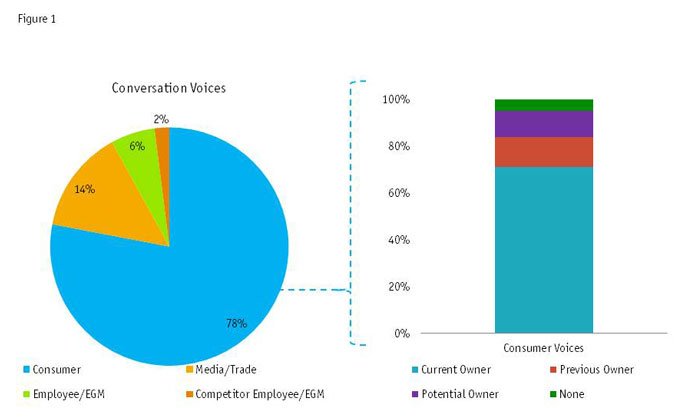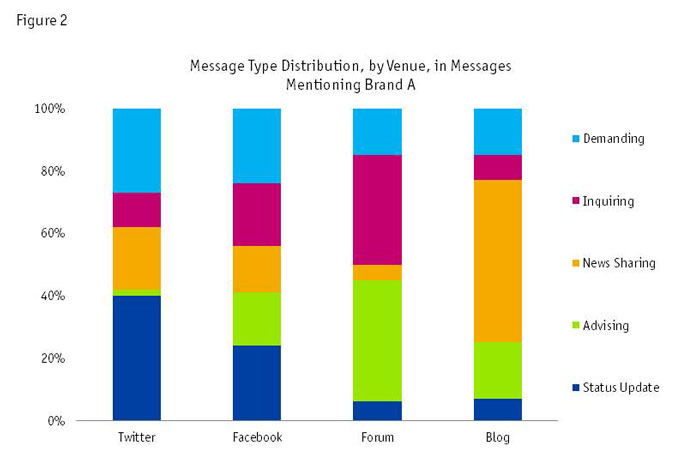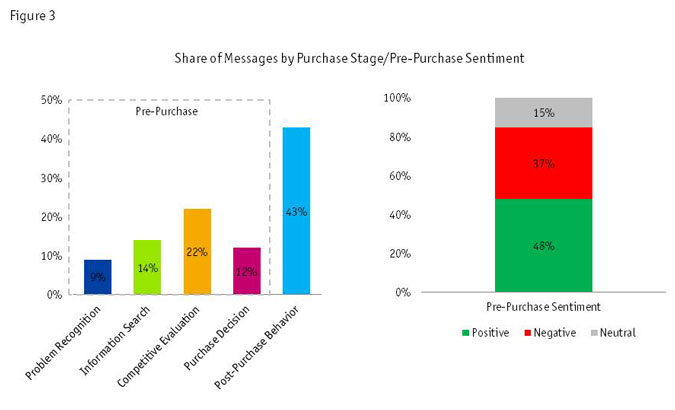Editor's note: Jasper Snyder is vice president at Converseon, a New York research company. He can be reached at jsnyder@converseon.com. This article appeared in the February 11, 2013, edition of Quirk's e-newsletter.
The early history of social intelligence will show that corporations were initially only interested in what consumers were saying about their brands from a public relations or reputation perspective. They wanted to know how much conversation there was, where it was taking place and - on a very general level - how their brand was perceived in social media conversation. Tools for this type of information provided every user with the same basic set of analyses and weren't tailored to exact industries, models or functional areas within a business.
As the use of social media becomes a part of day-to-day life for more and more people, however, the ways corporations tap into the huge sea of publicly-available data is changing. Myriad internal-use cases are being deployed, each with different data requirements. There is now a closer corporate focus on the ways social intelligence can meet business goals and brands are specifying operational goals that social intelligence can address. These goals are supported by key performance indicators (KPIs), which are themselves supported, in turn, by distinct types of social analysis.
However, those basic analyses that proved useful historically (i.e., those representing the volume of relevant messages or their general sentiment) cannot provide the level of granularity and insight to support these KPIs. There is a requirement for analysis to be underpinned by custom-configured, business-question- and brand-specific classification of social media messages. These classifications - both in terms of their application and from the perspective of their methodological genesis - represent a new frontier for social intelligence.
A closer look
Let's take a closer look at some of the ways in which custom social intelligence classifications are being used by corporations today.
Campaign development
For campaign development, it's crucial to understand where - and how - your target audience is engaging in online conversation. You can only do that by establishing and applying a classification to understand the volume of conversation by customer segment or conversation voice.

This classification will change from business to business. For the automotive industry, there might be four broad categories of audience - perhaps consumer, media/trade, employee and competitor employee - with the consumer segment broken out according to whether someone is a current, previous or prospective owner of a vehicle (Figure 1). In the pharmaceutical space, the segments would change. There might be segments such as patient, caregiver, physician, insurer and industry expert. These segments can be defined by the brand and all insights that are then based on social data can be viewed through the lens of these custom-defined market segments, which may in fact dovetail with a brand's existing consumer segmentation. Only with this level of granularity and accuracy can a brand plan an effective social media strategy.
Interestingly, campaign development is just one example of a use case where understanding who is taking part in the conversation is important. Consider the possibilities of using social intelligence as an input into compliance management, for example. In that case, it's vital that a brand can identify its own employees versus those of its competitors (or indeed any other non-employee segment).
Let's look at another custom classification, again in the realm of campaign development. When outlining a social media strategy, a brand must understand the nature of the conversation around the brand or product. One way of doing this is to understand which types of messages are being posted: Are they simply anecdotal or are there questions being asked that the brand can help answer? Is there misinformation about the brand being shared? In this situation, we would configure a classification to calculate the volume of conversation by message type. Figure 2 shows how the type of content varies by the type of venue in which the conversation is taking place.

Crisis management
Let's now take a deep dive into the crisis management use case and see how custom classifications drive value when compared to analysis based on standard metrics alone.
As outlined above, a brand using social intelligence for crisis management might previously have wanted to know three things:
-
the size of the crisis;
-
where the conversation that related to the crisis was taking place; and
-
the general effects on brand reputation.
Let's assume for the sake of argument that the brand in question has a relatively unique name so we don't have to discuss how difficult it is to isolate relevant conversation around a brand using Boolean searches or some type of post-Boolean approach. Let's also assume that the brand can access a wide range of online conversation data so it's listening to a significant amount of the relevant conversation. In terms of its three informational goals, the brand can now, via relatively straightforward social media analysis, understand the volume of conversation, how it's changing day by day and what it looks like in aggregate over a period of time. Second, a brand can see the individual domains where conversation is taking place, which might inform its engagement strategy. Finally, by analyzing the conversation for sentiment, the brand might be able to see changes in overall brand perception and how these are affected as the crisis develops and diminishes.
Once you start using custom classifications, however, the analysis becomes much more useful and actionable. Using a broad segmentation classification enables the brand to understand which market segments are taking part in the crisis-related conversation so it can understand, for example, whether it's its own customers, prospective customers or competitors fueling the conversation. The brand can take this further with custom classification pertaining to age (the brackets can be defined by the brand), location (this could be city, state or country), profession and gender. Now the brand has a very sophisticated understanding of who's taking part in the conversation around the issue at hand, which is a great first step in outlining a crisis management strategy.
Next, as illustrated in the previous examples, using a message-type classification will allow a brand to understand the nature of the crisis conversation: Are people asking questions about the effect on them personally or are they ranting? How can the brand best engage with them and create targeted responses? Lastly, rather than predefining which topics might be driving conversation, those that are measured will vary from business to business and sector to sector. In this way, sentiment becomes actionable because first, it's attributed to a particular issue and second, the issue is relevant to the brand (Figure 3).

A cumulative perspective
Once a brand starts combining standard and custom classifications, things get really interesting. Let's walk through some of the steps of another type of data analysis, looking at the benefits of each subsequent step from a cumulative perspective. We're going to pay particular attention to how the combination of standard and custom classifications makes data immediately actionable.
The two standard analyses the brand is going to use are based on volume and sentiment. First, via volume analysis, the brand can understand how much conversation there is around its brand online. Second, it might want to analyze that brand-specific conversation for sentiment. So now it has identified a set of data that pertains to its brand and knows generally how that brand is perceived. A third step can now be added to the analysis, which is to use the purchase-funnel custom classification. This metric tells the brand where the person engaging in the conversation is in relation to purchase decision. Are they, for example, still considering which brand to purchase or have they already bought the product?
It's important to note that this example of a standard classification, like sentiment, should not be seen as a one-size-fits-all concept. Depending on your industry and target of analysis, the way prospects and customers express themselves regarding purchase decisions will differ greatly and require manual or automated analysis to home in on different cues accordingly.
Once these classifications have been combined, a brand can dive in for instantly-actionable data. It has a dataset that can be separated according to which step of the purchase funnel the brand is interested in. Now the brand can zero in on negative posts made by people who have just bought its product or service, which might reveal issues in terms of the retail experience, customer service or product functionality.
Huge benefits
The use of custom classifications can bring huge benefits to each of the use cases enabled by social intelligence: R&D, campaign effectiveness, brand management, search marketing, risk management, customer care and more. We should expect the use of these classifications to continue to grow as corporations become evermore sophisticated in the ways they use social media data. This will happen both in terms of expanding the functional areas into which the data is passed and also from the perspective of bringing new approaches and sophistication to existing use cases. We should also expect this level of analysis to be able to be performed on an almost infinite scale, as natural language processing frameworks are used by organizations to augment or replace domain experts who otherwise would have to manually classify messages.
The corporations that embrace analysis approaches based on advanced classifications will be the ones taking the lead as we move further into the new social paradigm.
